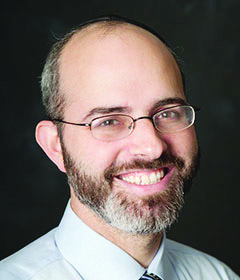 May these words of Torah serve as a merit le’iluy nishmat Menachem Mendel ben Harav Yoel David Balk, a”h.
May these words of Torah serve as a merit le’iluy nishmat Menachem Mendel ben Harav Yoel David Balk, a”h.
This week we learned Bava Kama 101 and 103. These are some highlights.
Bava Kama 101: May one use painted reed mats for s’chach?
A man acquired reed mats that had been woven to be used as s’chach, with the intent of putting them atop his sukkah as s’chach. His wife did not like how they looked. He proposed painting them to make them look colorful, festive and joyous. He asked Rav Shlomo Kluger, “May I paint the mats and still use them for s’chach?” The Gemara in Tractate Sukkah teaches that only pesolet goren vayekev, the remnants of the grain silo and vineyard, may be used for s’chach. Kosher s’chach is a material that grew in the ground, was detached from the ground, and was still in a raw form—material that could not yet become ritually impure. Would painting the mats ruin them? Would it mean that they were no longer pesolet goren vayekev?
Ha’elef Lecha Shlomo (Orach Chaim Siman 364) permitted the man to paint his mats and still use them for s’chach.
He advanced several arguments for this point of view.
One, the reason to possibly disqualify would be based on the concept of shinuy koneh, a change causes an acquisition. A thief who steals an object and then changes it might acquire it. Several times in Bava Kama we have learned that the issue of shinuy is disputed. There are many who are of the opinion that shinuy bimkomo omeid, change of object does not change its halachic status. According to those opinions, certainly, the painted mats would be kosher s’chach.
Secondly, perhaps even those who feel that change of object does impact the halachic status of an item would agree that the laws of s’chach would not be impacted by a shinuy to the object. Change is impactful in laws that are based on externals. A stolen object has a unique status because of what someone did. A person lifted the object out of the house of its owner and tried to acquire it. An external act impacted the item. Such laws are weak. Shinuy of the object can cause those laws to fall away. The Gemara mentioned the law of shinuy in regard to esnan, an animal given as payment to a prostitute. There, as well, the animal’s disqualification is not because of an intrinsic feature of the beast. It is because of what a person did with the animal. Such laws are weak and a shinuy can remove the law. Kosher s’chach is a law that is intrinsic to the item. Pesolet goren vayekev is an intrinsic quality. Some items are remnants of the field and still natural. A change cannot cause an intrinsic status to be lost. Painting the mat did not make the mat able to become impure. As a result, the s’chach would stay kosher even according to the authorities who are of the opinion that changing a stolen object, or an esnan, impact laws of theft and suitability of a sacrifice.
Finally, our Gemara would be another reason to be lenient. Our Gemara proposed that chazuta lav milta, coloring is not a real matter. Wool that is painted might not be viewed by halacha as wool and paint. Rather, halacha might view it as wool. The paint is gone. Since applied paint is viewed as a matter that has vanished and merely transformed the color of another thing, the s’chach that was painted would be kosher. There is no law about which color s’chach should have. The law merely insists that s’chach be an item that is natural and cannot become tamei. Painting the mat would not make the mat able to become tamei. Halacha views the paint as gone, so the natural s’chach is all that is there.
Some might argue that the paint would be a chatzitzah—a barrier between the s’chach and the person sitting in the sukkah, according to the point of view that chazuta milta hi, color is viewed as an independent item. Rav Kluger rejected that point of view. The mishnah in Sukkah teaches that a colored sheet placed near the s’chach would not disqualify the sukkah. Since the sheet is placed to beautify the s’chach, it loses its identity to the s’chach and is not considered a barrier or non-kosher s’chach. The man wished to paint his mat to make it pretty. What is added for beauty is not a chatzitzah. Rav Kluger permitted painted mats to be used as s’chach. (Mesivta)
Bava Kama 103: Travel to return theft
A man wracked by guilt once approached Rav Zilberstein with a question. He had a friend who had been working in the home of an elderly Jewish immigrant from France. The elderly man needed help. His friend lived with the old man and tended to his every need. One day, he went with his friend to visit the Frenchman. The friend felt very comfortable in the home of the old man. The old man went down to take a nap. The friend brought him into the kitchen, opened the fridge, took out the orange juice and gave him a cup to drink. He had never gotten permission from the old man for the juice. He left the apartment and did not think anything of it. Years later he learned that one may not take the possessions of someone else without permission. He felt guilt. That cup of juice had been stolen. When he went to return the value of the drink to the old man he found out that the man had passed away. His children lived in France. He asked the Rav, “Must I travel to France to try and return to the children of the deceased the value of the cup of juice that I took?”
Rav Zilberstein ruled that even though the old man would likely not have minded his taking the cup, he was not allowed to take the drink without permission. His friend had no right to open the fridge and give him the orange juice. However, he did not need to travel to France to return the value of the drink to the heirs of the deceased.
Our Daf teaches that if someone stole and then swore falsely, taking an oath that he did not owe anything to his victim, he would be obligated to go all the way to Medea to return the principal to the victim. The Gemara explains that this is based on a verse, “O mikol asher yishava alav lasheker veshilam oto berosho vachamishito yoseif alav la’asher hu lo yitnenu beyom ashmato—Or anything about which he had sworn falsely, he shall repay its principal and add its fifth to it; he shall give it to its owner on the day he admits his guilt” (Vayikra 5:24). “La’asher hu lo yitnenu beyom ashmato—he shall give it to its owner on the day he admits his guilt” teaches that in a case of a false oath he must it give it to its owner. He must go all the way to Medea to give it to the victim.
Rambam (Hilchot Gezeila 7:9) explains that when a thief steals and swears falsely, the victim despairs. Hearing the oath makes the victim think that he will never get the object back. Rav Yosef Dov Soloveitchik explained that such a theft is a deeper sin. It was a more vicious robbery. As a result, the Torah obligates the thief to make great efforts at amends. A regular thief, who did not swear falsely, is not obligated by the Torah to pursue his victim. He does not need to travel afar and deliver the funds into the hands of his victim to ensure that the victim is made whole.
In the case of the man who felt guilt about the wrongly taken orange juice, he had not sworn falsely. It was theft, but not severe theft. He did not have to travel all the way to France to make restitution. Rav Zilberstein advised that he should have a friend acquire from him money worth the cup of juice on behalf of the children of the old man who were in France. As a benefit, the friend could acquire title to the money without informing them. According to Jewish law, it would then be considered that the money had been returned to them. Even though they had not received the money in their hands, there certainly would no longer be any sin left. (Daf Digest, Reshimot Shiurim Al Masechet Bava Kama)
By Rabbi Zev Reichman










